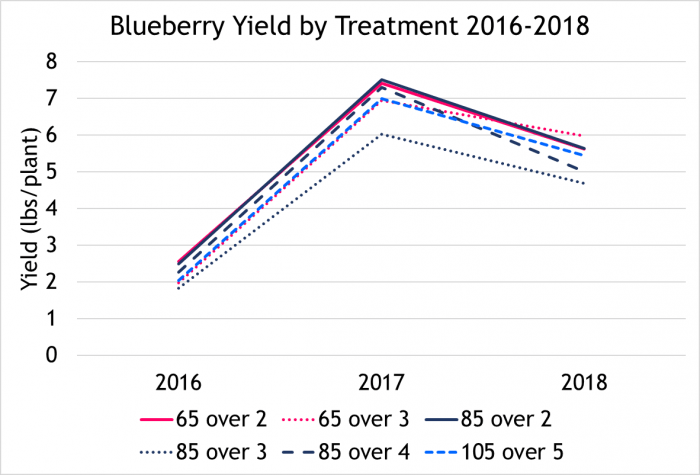Emmalea Ernest, Scientist – Vegetable & Fruit Crops; emmalea@udel.edu
It is soon time to apply nitrogen fertilizer to blueberries. Urea or ammonium sulfate are the recommended materials. Use urea if your soil pH is in the recommended range of 4.5 to 5.0 and use ammonium sulfate if pH is greater than 5.0 or if you have a history of rising pH because of soil properties, high pH irrigation water, mulch materials or other factors.
The nitrogen (N) fertilization recommendation for established blueberry plants in the Mid-Atlantic region is 65 lbs/acre (1.2 oz/plant) each year. The recommended application timing is to apply half of the N at bloom and the remaining half 6 weeks later. In other regions of the U.S. the N fertilization recommendation for blueberries is higher and recommended applications occur later in the season. For example, in Georgia and Mississippi the recommendation for bearing blueberries grown in soil is 80-120 lbs of N/year, split over 4-5 applications with final applications in July or August. The recommendations for Oregon growers are 100-165 lbs of N/year with applications at bloom, mid-May and mid-June. The vastly different N fertilization rates and application timings in other regions have prompted questions about whether the recommendations for the Mid-Atlantic are high enough and whether a later season N application would be beneficial to blueberry yield.
Blueberry Nitrogen Fertilization Study in Georgetown, Delaware
A blueberry nitrogen rate and timing study was undertaken in an established planting of ‘Chandler’ northern highbush blueberries at the Carvel Research and Education Center in Georgetown, Delaware. The planting was six years old at the time the study began and yield data was collected over a three year period. Six different rate/timing treatments were tested (Table 1.). Ammonium sulfate was applied to the mulched area, followed by overhead irrigation.
Table 1. Nitrogen Rate and Application Treatments Tested
| Lbs of N over # Applications | Application Timing |
| 65 over 2 | Bloom, 6 wks post bloom |
| 65 over 3 | Bloom, 3 wks and 6 wks post bloom |
| 85 over 2 | Bloom, 6 wks post bloom |
| 85 over 3 | Bloom, 3 wks and 6 wks post bloom |
| 85 over 4 | Bloom, 3 wks, 6 wks and 10 wks post bloom |
| 105 over 5 | Bloom, 3 wks, 6 wks, 10 wks, and 14 wks post bloom |
Plots consisted of three plants and there were four replications per treatment, resulting in 12 plants that received each nitrogen treatment. Yield was measured on an individual plant basis with harvest twice per week.
Over the three years of the study there were no statistically significant differences in yield between the six nitrogen fertilization treatments (Figure 1). In 2016 a late freeze damaged flowers and reduced yields in all treatments. The highest yields were obtained in 2017 followed by slightly lower yields in 2018.
Additionally, leaf tissue analysis of samples collected from each plot in early August of 2016 and 2017 did not reveal any statistically significant differences in N and all samples were in the sufficient range.

Figure 1. Blueberry yield in pounds/plant for each N fertilization treatment over the three years of the study. There were no statistically significant differences in yield between treatments in any of the three years.
Conclusions
Additional nitrogen, further splitting of nitrogen applications and later season nitrogen applications did not increase yield in Chandler highbush blueberries. Plants that received the current recommendation of 65 lbs/acre of N with half applied at bloom and half six weeks later yielded equivalently to treatments receiving more N, later N applications and more frequent N applications. The current Mid-Atlantic nitrogen recommendation for highbush blueberries provides adequate N, even in the southern part of the region. Mid-Atlantic blueberry growers should use the current N recommendation rate and timing for established plantings.
Growers should consider applying higher than the recommended rate of N in certain circumstances. If the material used to mulch blueberries is not well aged (<1 year) it will tie up N and additional N will be needed to ensure plant availability. If leaf tissue tests (sampling recommended in August) indicate N deficiency, additional N should be supplied in the spring of the following year. If plants are not producing adequate new growth, additional N might be warranted if other causes of poor vigor (soil pH, inadequate soil moisture, root disease, weed competition) are ruled out.
